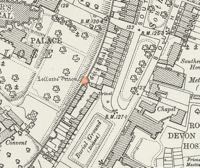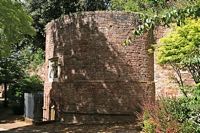
Lollards Tower or Prison
aka the Bishop's Tower
Page updated 19th December 2016
Stonework in Exeter's City Wall can be traced back to the Roman occupation of the ridge that overlooked the Exe. After the Romans retreated, the city wall decayed with the robbing of stone and a general lack of repair. The city was under siege or occupied by the Danes in the tenth-century until Athelstan removed them in 926 and proceeded to rebuild the decayed wall. The wall was reinforced and repaired many times until the seventeenth century, when the last time it functioned as a defence for the city was in the Civil War.
Lollards Tower is one of the medieval additions to the wall of an indeterminate date. It was named Lollards Tower after the followers of John Wycliffe, an Oxford academic and theologian (d1384), a 14th century dissident priest who, against the wishes of the Pope, translated the bible into English. His supporters were known as Lollards–from a Dutch word meaning 'mumbler' of 'idle babler'. A contemporary wrote "Every second man that you meet, is a Lollard!". They became an influence on the thinking of Martin Luther a hundred years later.
The tower was, by Bishop John booth in 1462, used as a prison, more especially to hold the Lollard heretics who followed Wycliffe, before they were taken to Southernhay to be burnt at the stake. It was later used as a store.
In 1447 it was described as "the most costelew defence and most stately towre of alle the city." By the late 16th Century it was three storeys high and described as a castle, rather than a tower.
The doorway was made by order of the Privy Council, in 1623, to allow the Bishop a way of leaving the Bishop's garden without passing through the city. This was against the wishes of the Mayor and Corporation who feared it would introduce a weak point in the defences. A stream ran in a ditch by the wall and the Bishop was required to build a bridge from the postern across the stream.
In 1912, Lollards Tower was rebuilt and the coat of arms of Bishop Robertson (1903 to 1916) placed over the arched entrance known as Bishop Carey's Postern.
Sources: greatsite.com for the information on Wycliffe, History of Exeter by Alexander Jenkins, Exeter's City Walls by Mark Stoyle. British Newspaper Archive
│ Top of Page │

